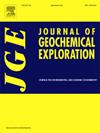乔治纳盆地地下水地球化学的多元成分分析:沉积物矿物系统的新见解
IF 3.3
2区 地球科学
Q1 GEOCHEMISTRY & GEOPHYSICS
引用次数: 0
摘要
澳大利亚北部的乔治纳盆地拥有巨大的战略矿产潜力,特别是锌和磷酸盐,这对澳大利亚的经济和向净零排放过渡至关重要。本研究应用多元统计工具对盆地区域寒武系灰岩含水层的地下水地球化学进行了研究,探讨了乔治亚盆地北半部沉积型磷酸盐和锌铅矿物系统的勘探前景。鲁棒主成分分析(Robust principal component analysis, rPCA)发现Mo和I−(以及Rb和Al)是影响地下水中磷含量变化的关键元素。然后,k均值聚类分析绘制了这些P关系明显的空间聚类子集。这项研究最终建立了一个新的地球化学指数(Phos#),用于识别可能来自磷酸盐矿化的水文地球化学异常。五个区域被认为是最有前景的,其中三个位于Elliott附近,一个位于Central georgia和Undilla子盆地。水文地球化学在探测区域沉积型铅锌矿化方面也很有价值。alexander - wonarah基底高地和Undilla次盆地(地下水中Pb或Zn含量升高)的放射性成因Pb同位素异常值(206Pb/204Pb值在22.00 ~ 24.00之间)与地表或钻孔中观测到的硫化物具有空间相关性,与Georgina盆地joplin型、Mississippi Valley型锌- Pb矿化的放射性成因Pb同位素特征一致。这种对地下水化学的区域深度评估提供了一种有效的缩小规模的工具,为后续工作提供了明确的目标,并得到了关于如何将这种多变量、基于指数的方法转化为其他沉积盆地和/或矿化组合的讨论的支持。本文章由计算机程序翻译,如有差异,请以英文原文为准。
Multivariate compositional analysis of groundwater geochemistry in the Georgina Basin: New insights for sediment-hosted mineral systems
The Georgina Basin in northern Australia holds significant potential for strategic minerals, particularly zinc and phosphate, which are crucial for Australia's economy and transition to net-zero. This study applied multivariate statistical tools to groundwater geochemistry from the basin's regional Cambrian Limestone Aquifer to investigate the prospectivity of sediment-hosted phosphate and Zn–Pb mineral systems in the northern half of the Georgina Basin. Robust principal component analysis (rPCA) identified Mo and I− (as well as Rb and Al) as key elements associated with the variation of P in groundwater. K-means cluster analysis then mapped a subset of spatial clusters where these P relationships were evident. This investigation culminated in the creation of a new geochemical index (Phos#) for identifying hydrogeochemical anomalies likely sourced from phosphate mineralisation. Five areas were deemed most prospective using Phos#: three near Elliott, and one in each of the Central Georgina and Undilla Sub-basins.
The hydrogeochemistry was also valuable in detecting regional sediment-hosted Zn–Pb mineralisation. Radiogenic Pb-isotope outliers (206Pb/204Pb of 22.00 to 24.00) in the Alexandria-Wonarah Basement High and Undilla Sub-basin (which were supported by elevated Pb or Zn in groundwater), were spatially correlated with observed sulfides at the surface or in drillholes and consistent with the radiogenic Pb-isotope signature of Georgina Basin's Joplin-type, Mississippi Valley Type Zn–Pb mineralisation.
This regional in-depth assessment of the groundwater chemistry provides an efficient scale-reduction tool with clear targets for follow-up, and is supported by a discussion on how this multivariate, index-based approach can be translated to other sedimentary basins and/or mineralisation assemblages.
求助全文
通过发布文献求助,成功后即可免费获取论文全文。
去求助
来源期刊

Journal of Geochemical Exploration
地学-地球化学与地球物理
CiteScore
7.40
自引率
7.70%
发文量
148
审稿时长
8.1 months
期刊介绍:
Journal of Geochemical Exploration is mostly dedicated to publication of original studies in exploration and environmental geochemistry and related topics.
Contributions considered of prevalent interest for the journal include researches based on the application of innovative methods to:
define the genesis and the evolution of mineral deposits including transfer of elements in large-scale mineralized areas.
analyze complex systems at the boundaries between bio-geochemistry, metal transport and mineral accumulation.
evaluate effects of historical mining activities on the surface environment.
trace pollutant sources and define their fate and transport models in the near-surface and surface environments involving solid, fluid and aerial matrices.
assess and quantify natural and technogenic radioactivity in the environment.
determine geochemical anomalies and set baseline reference values using compositional data analysis, multivariate statistics and geo-spatial analysis.
assess the impacts of anthropogenic contamination on ecosystems and human health at local and regional scale to prioritize and classify risks through deterministic and stochastic approaches.
Papers dedicated to the presentation of newly developed methods in analytical geochemistry to be applied in the field or in laboratory are also within the topics of interest for the journal.
 求助内容:
求助内容: 应助结果提醒方式:
应助结果提醒方式:


